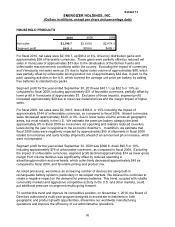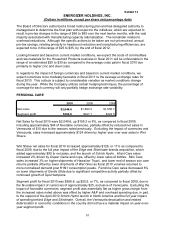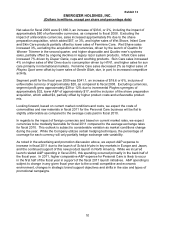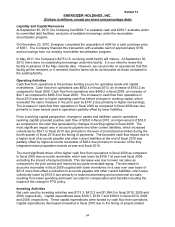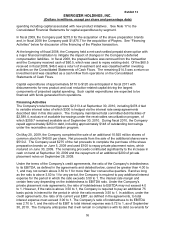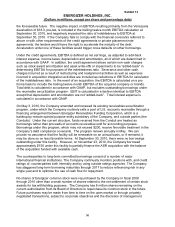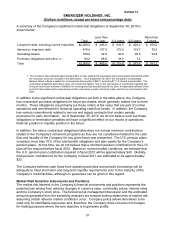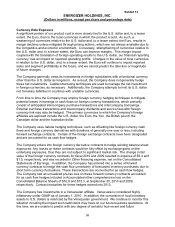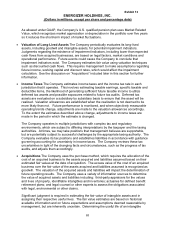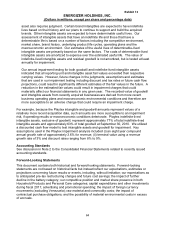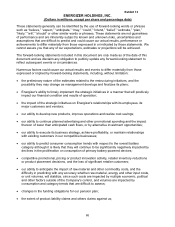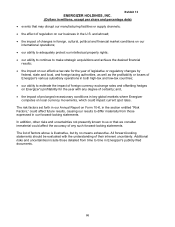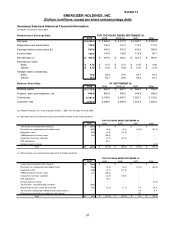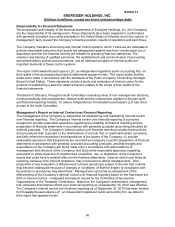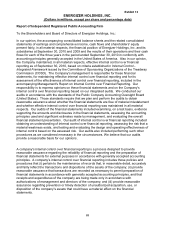Energizer 2010 Annual Report Download - page 70
Download and view the complete annual report
Please find page 70 of the 2010 Energizer annual report below. You can navigate through the pages in the report by either clicking on the pages listed below, or by using the keyword search tool below to find specific information within the annual report.
Exhibit 13
ENERGIZER HOLDINGS, INC.
(Dollars in millions, except per share and percentage data)
60
in the Consolidated Statements of Cash Flows as the period activity associated with the
Company’s deferred compensation liability, which was cash flow from operations.
Seasonal Factors
The Company's Household Products segment results are impacted in the first quarter of the
fiscal year by the additional sales volume associated with the December holiday season,
particularly in North America. First quarter sales accounted for 32%, 31% and 32% of total
Household Products net sales in fiscal 2010, 2009 and 2008, respectively. In addition, natural
disasters, such as hurricanes, can create conditions that drive exceptional needs for portable
power and spike battery and lighting products sales.
Customer orders for the Company’s sun care products are highly seasonal, which has
historically resulted in higher sun care sales in the second and third quarters of our fiscal year
and lower sales in the first and fourth quarters of our fiscal year. As a result, sales, operating
income, working capital and cash flows for the Personal Care segment can vary significantly
between quarters of the same and different years due to the seasonality of orders for sun care
products.
Other factors may also have an impact on the timing and amounts of sales, operating income,
working capital and cash flows. They include: the timing of new product launches by
competitors or by the Company, the timing of advertising, promotional, merchandising or other
marketing activities by competitors or by the Company, and the timing of retailer merchandising
decisions and actions.
Environmental Matters
The operations of the Company, like those of other companies, are subject to various federal,
state, foreign and local laws and regulations intended to protect the public health and the
environment. These regulations relate primarily to worker safety, air and water quality,
underground fuel storage tanks and waste handling and disposal. The Company has received
notices from the U.S. Environmental Protection Agency, state agencies and/or private parties
seeking contribution, that it has been identified as a “potentially responsible party” (PRP) under
the Comprehensive Environmental Response, Compensation and Liability Act, and may be
required to share in the cost of cleanup with respect to eight federal “Superfund” sites. It may
also be required to share in the cost of cleanup with respect to state-designated sites or other
sites outside of the U.S.
Accrued environmental costs at September 30, 2010 were $10.2, of which $2.8 is expected to
be spent in fiscal 2011. This accrual is not measured on a discounted basis. It is difficult to
quantify with certainty the cost of environmental matters, particularly remediation and future
capital expenditures for environmental control equipment. Nevertheless, based on information
currently available, the Company believes the possibility of material environmental costs in
excess of the accrued amount is remote. Total environmental capital expenditures and
operating expenses are not expected to have a material effect on our total capital and
operating expenditures, consolidated earnings or competitive position. However, current
environmental spending estimates could be modified as a result of changes in our plans,
changes in legal requirements, including any requirements related to global climate change, or
other factors.
Inflation
Management recognizes that inflationary pressures may have an adverse effect on the
Company, through higher material, labor and transportation costs, asset replacement costs and


